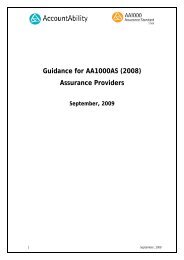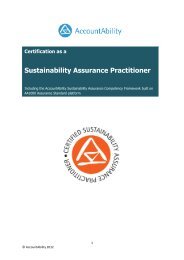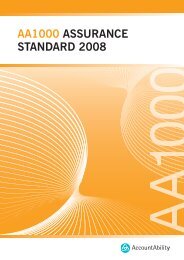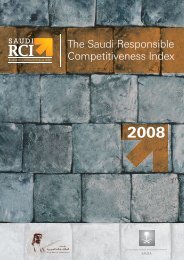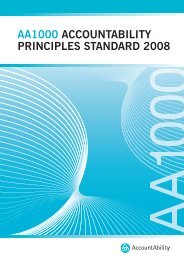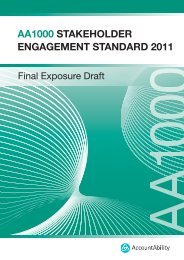The Stakeholder Engagement Manual Volume 2 - AccountAbility
The Stakeholder Engagement Manual Volume 2 - AccountAbility
The Stakeholder Engagement Manual Volume 2 - AccountAbility
You also want an ePaper? Increase the reach of your titles
YUMPU automatically turns print PDFs into web optimized ePapers that Google loves.
Analyse and Plan<br />
P5: REVIEWING YOUR PROGRESS<br />
Explanation to Template T5<br />
SUGGESTED METHODOLOGY M5:<br />
ASSESSING YOUR CURRENT ORGANISATIONAL RESPONSE<br />
Th e purpose of this activity is to establish a clearer picture of the degree and<br />
mechanisms that the business currently has in place to address specifi c issues. It involves<br />
an assessment of current processes of management and stakeholder engagement in<br />
relation to the issue, and helps you to identify areas for improvement.<br />
• Using the Template 5 (below) as guidance, investigate what level of<br />
development your organisation has reached in relation to each of your<br />
prioritised issues, and note any particular areas where organisational response<br />
enablers are weak in relation to a particular issue. <strong>The</strong> Template guides you in<br />
doing this and helps to capture the results of this assessment.<br />
• Chart issues on Issue/Response matrix (above) to highlight those areas<br />
where you fall into the red risk zone or green opportunity zone.<br />
• Identify target levels of development for specifi c aspects of your approach to<br />
prioritised issues or stakeholder map.<br />
• Finally, consider the fi nancial resources that may be required for engagement,<br />
as well as for the possible outcomes of engagement. Are key budget holders<br />
committed to supporting this process? Is it clear to which degree fi nancial<br />
resources will be made available?<br />
THINGS TO CONSIDER<br />
• This process should draw on sources of expertise throughout the company,<br />
including aspects of stakeholder management processes already documented<br />
in policies and guidelines as well as through interviews, workshops or meetings<br />
with key individuals within the company.<br />
• <strong>The</strong> “current engagement activities” row should ideally be considered in<br />
conjunction with the analysis of current engagement undertaken described on<br />
p63.<br />
<strong>The</strong> different rows of this table help you to assess whether your business’ current management systems / policies and processes<br />
are adequate for the maturity of the issue in question.<br />
If all of your responses are 1, your organisation is in a good position to respond to the issue in a strategic manner.<br />
If your answers are all 2, then your business response can be considered as embedded.<br />
If all answers are equal to 3, then the current processes are developing.<br />
Answers of 4 indicate an exploratory approach. Finally if the majority of responses are 5, this indicates that your company is<br />
not addressing the issue.<br />
Consider your organisational response in light of the maturity of the issue – are you a leader or a laggard in relation to this issue?<br />
How does this relate to your strategic objectives and assessment of risks and opportunities in this area?<br />
Highlight areas for improvement in the fi nal row.



